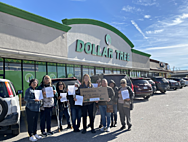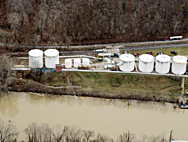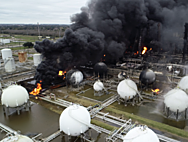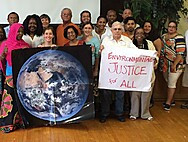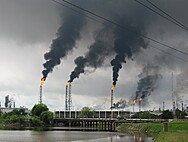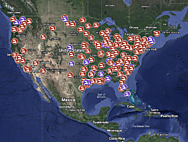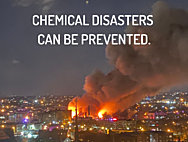Latest News
Media Contact
Deidre Nelms
Director of Communications
(802) 251-0203 ext. 711
dnelms@comingcleaninc.org
Subscribe to our quarterly newsletter!
Press Releases
May 7, 2025
Community-driven testing again reveals chemicals of concern in dollar store products
The Campaign for Healthier Solutions (CHS) today published the results of a year-long effort to collect, test, and screen dollar store products for chemicals of concern. Highlighted products of concern purchased at Dollar Tree/Family Dollar and/or Dollar General include: “Baby Shark” baby lotion containing a formaldehyde-releasing chemical; daily moisturizer containing a chemical banned in European cosmetics; light-up children’s bracelets, plastic roses and mini candy pails containing lead; children’s products made with polyvinyl chloride or PVC, and receipts containing bisphenol-S. Published the week of Mother’s Day, “Product Testing for the People: Pitfalls, Persistence, and Progress in Transforming Dollar Stores” provides safe shopping tips for families and actionable recommendations for Dollar Tree and Dollar General to expand, improve, and enforce their chemical policies. The report also highlights loopholes in federal law that allow companies to sell products containing chemicals of concern, showing the importance of corporate action. Take action!
Read MoreMay 5, 2025
Sweeping exemption requests from polluters are an affront to fenceline communities
Today 34 individuals and organizations sent a letter to the U.S. Environmental Protection Agency (EPA) Administrator Lee Zeldin, opposing an unprecedented Presidential exemption that would allow hundreds of chemical plants to simply ignore stricter emissions standards that were finalized last year. Among these was the “HON rule”, which requires over 200 chemical plants - shown to contribute to high cancer risk in fenceline communities - to conduct fenceline monitoring for six cancer-causing air pollutants and take action to prevent leaks if emissions exceed certain thresholds. A recent request from chemical industry lobbyists seeks to exempt all HON facilities from complying with the new standards.
Read MoreMarch 11, 2025
Trump Administration’s Decision to Rehash Chemical Disaster Prevention Rules Will Endanger Millions of Workers and Fenceline Community Residents
The U.S. Environmental Protection Agency (EPA) announced Thursday that it plans to rehash regulations under the Risk Management Program (RMP). The decision comes after lobbyists for the chemical industry sent a letter requesting the agency weaken the rule requiring nearly 12,000 highly hazardous industrial facilities to prevent and plan for chemical disasters.
The EPA is bending to the will of corporate lobbyists who are seeking to eliminate stronger rules finalized in 2024. These more protective rules were the result of years of public debate and incorporated input from industry and the public alike, including advocacy by environmental justice, labor, occupational and public health, and environmental organizations.
Read MoreDecember 2, 2024
Communities Urge Dollar Stores to Remove Toxic Products from Shelves During Nationwide Pre-Holiday “Week of Action”
This week, supporters of the Campaign for Healthier Solutions are vising dollar stores in 30 states nationwide, with the support of health and environmental justice organizations, to demand products free of toxic chemicals.
Read MoreApril 9, 2024
Following a generation of grassroots advocacy, EPA takes major steps to reduce cancer-causing emissions from select chemical plants
Today, following years of advocacy from environmental justice organizations, the U.S. Environmental Protection Agency (EPA) finalized a rule to significantly reduce emissions of toxic air pollution from an estimated 200 chemical plants, in an effort to reduce elevated cancer risks experienced by fenceline communities. "It has taken nearly a whole generation of hard work to arrive in DC to make this announcement,” said Nalleli Hidalgo, Education Liaison with Texas Environmental Justice Advocacy Services (tejas), who introduced EPA Administer Michael Regan at today’s White House signing event. “As we take this moment in, we remember that we are not here as individuals but as a community standing in solidarity as we witness a key moment in rulemaking to reduce the daily harm our communities face, especially frontline communities that live directly across from HON facilities.”
Read MoreMarch 21, 2024
USEPA Rolls Out Rule to Address Worst-Case Chemical Disasters, Impacting Thousands of Facilities
The rule addresses a critical vulnerability in the protection of the country's waterways and communities. Thousands of facilities that manufacture, use and store some of the most dangerous chemicals brush up against waterways or are in flood-prone areas. The new policy comes after numerous disasters affecting drinking water supplies, wildlife habitats, and environmental justice communities that experience the brunt of extreme weather supercharged by climate change. “We are thankful that this administration is finally taking long overdue action to protect workers and communities against chemical disasters. Communities of color and the poor, who are experiencing the worst of the climate crisis, are also on the front lines of the fight against policies that permit billions of pounds of pollution and concentrate the most dangerous industries in our communities” said Michele Roberts, National Co-Coordinator of the Environmental Justice Health Alliance for Chemical Policy Reform (EJHA). “While we’re glad to see this rule taking steps in the right direction, we will continue to call on EPA to truly prevent disasters by transitioning away from inherently dangerous chemicals and processes as outlined in the Louisville Charter for Safer Chemicals.”
Read MoreMarch 1, 2024
EPA finalizes critical new chemical disaster prevention rule after years of community pressure
The U.S. Environmental Protection Agency (EPA) finalized critical updates to its Risk Management Program (RMP) rule today that will require covered facilities that use and store highly hazardous chemicals to better prevent, prepare for, and respond to disasters. The EPA also made non-classified information about RMP facilities publicly available online for the first time. Environmental health and justice advocates praised the new requirements and information access, while underscoring that EPA has the authority to take additional action outside of this rulemaking to protect communities and workers from toxic chemical harms.
Read MoreFebruary 22, 2024
Justice40 tools must ensure that farmworkers are recognized as Environmental Justice communities and receive benefits.
Today members of Coming Clean’s Farmworker Health and Justice Team submitted a comment urging the Council on Economic Quality (CEQ) to improve its Environmental Justice (EJ) Scorecard to ensure that federal agencies are providing Justice40 benefits to farmworkers. Phase One of the EJ Scorecard was launched in 2023, as mandated by President Biden’s Executive Order 14008 on Tackling the Climate Crisis at Home and Abroad. It is intended to track the progress of federal agencies in ensuring that 40% of climate, housing, energy, pollution remediation, and related federal benefits flow to “disadvantaged communities that are marginalized, underserved, and overburdened by pollution,” as part of the implementation of the Justice40 Initiative. Farmworkers are “a particularly important EJ community,” states the comment, because they often live in remote, rural areas, are disproportionately exposed to toxic pesticides, intense heat and high humidity, and wildfire smoke and pollution, and experience other health stressors such as substandard housing, harsh working conditions, and lack of access to affordable healthcare.
Read More
November 9, 2023
Over 270 hazardous chemical incidents have occurred in the United States this year alone, highlighting need for stronger chemical safety regulations
Over 825 hazardous chemical incidents – including fires, explosions and harmful chemical releases – have occurred since the beginning of 2021, and over 270 incidents have occurred this year alone, according to data published today by the Coalition to Prevent Chemical Disasters. Data included in the coalition’s online Chemical Incident Tracker is sourced from news reports. “Preventable chemical incidents are happening far too often across the country,” said Maya Nye, Federal Policy Director of Coming Clean, a member of the Coalition to Prevent Chemical Disasters. “Communities shouldn’t have to leave their homes, shelter in place, or worry for the safety of their air and water because chemical plants can’t contain their toxic chemicals. Hazardous facilities must be required to do more to protect workers and communities.”
Read MoreSeptember 26, 2023
Farmworkers, dollar store shoppers call on 99 Cents Only Stores to restrict harmful chemicals in products
Allied members of the Campaign for Healthier Solutions, including farmworkers, environmental justice advocates, parents, and dollar store shoppers demonstrated outside 99 Cents Only Stores Headquarters and local stores across the state, urging the company to phase out chemicals of concern from its products. A delegation representing the campaign also delivered a letter requesting a meeting with 99 Cents Only Stores’ interim Chief Operations Officer Michael Simoncic and Director of Compliance Edgar Flores, to begin the work of drafting a corporate chemical management policy.
Read MoreJune 30, 2023
Statement of gratitude to Richard Moore for his twelve years as National Co-Coordinator of EJHA
With warmth and deep appreciation, we thank Richard Moore for his twelve years as National Co-Coordinator of the Environmental Justice Health Alliance for Chemical Policy Reform (EJHA). Richard will be stepping down from this role today, while continuing to serve as Co-Coordinator of Los Jardines Institute in Albuquerque, New Mexico, an affiliate member of EJHA. During his time as National Co-Coordinator, Richard helped secure historic commitments from the White House and federal agencies to advance environmental justice, the result of decades of dedicated bottom-up organizing rooted in solidarity and respect.
Read MoreMay 31, 2023
Dollar General urged to protect worker and customer health at annual shareholder meeting
Dollar General shareholders urged the discount retailer to better protect the health of workers and shoppers today at its annual shareholder meeting in Goodlettsville, Tennessee. Shareholder advocates with the Campaign for Healthier Solutions (CHS) called on Dollar General to phase out chemicals of concern from its products and receipts, and voted yes on a shareholder proposal requesting an independent worker safety and well-being audit. New testing conducted by the Ecology Center Health Stuff Lab has found hormone-disrupting bisphenol S (BPS) in receipts that were printed in select stores of the major discount retailers in 2022, including Dollar General.
Read MoreApril 21, 2023
EJHA and Coming Clean celebrate historic executive order deepening federal commitments to Environmental Justice
Today, President Biden signed the executive order Revitalizing Our Nation’s Commitment to Environmental Justice for All, directly incorporating many recommendations of the White House Environmental Justice Advisory Council. The executive order makes clear that the pursuit of environmental justice is a duty of all executive branch agencies and should be incorporated into their missions, directs agencies to consider the cumulative health impacts of pollution on communities, and directs agencies to strengthen their direct engagement with impacted communities. The White House also published an Environmental Justice Scorecard and announced new Justice40 covered programs.
Read MoreApril 6, 2023
EPA Action to Reduce Cancer-Causing Air Pollution Is Critical and Long Overdue
Today, the U.S. Environmental Protection Agency (EPA) proposed a rule to significantly reduce emissions of toxic and other harmful air pollution from chemical plants, intended to reduce air toxics-related cancer risks in fenceline communities. Coming Clean and the Environmental Justice Health Alliance for Chemical Policy Reform (EJHA) applauded the EPA for committing to take action to dramatically reduce emissions of cancer-causing chemicals from chemical and polymer plants. Under the proposed rule, these facilities will be required to conduct fenceline air monitoring to ensure compliance with new regulations, a priority for fenceline communities who have testified and submitted comments to the EPA in recent years.
Read MoreMarch 23, 2023
Coming Clean lobbies for a Farm Bill that centers human health by reducing reliance on toxic chemicals
Today, Coming Clean hosted a lobby day for members to meet with Congressional leaders to urge them to prioritize community food sovereignty and farmworker protections in the upcoming farm bill reauthorization, while incentivizing reductions in pesticide use. Members from across the country, including small farmers and farmworkers, scheduled visits throughout the day with lawmakers from their districts to highlight reforms that are most important to them and their communities.
Read More
February 25, 2023
New map shows toxic chemical releases, fires and explosions occur every two days on average across the U.S.
A new map released by the Coalition to Prevent Chemical Disasters today shows that the toxic train derailment in East Palestine, Ohio is one of at least 224 incidents involving hazardous chemicals – including toxic releases, fires and explosions – that have occurred since January 1, 2022. The map will be periodically updated through the year to reflect new chemical incidents.
Read More
January 27, 2023
Dollar General signs onto the Chemical Footprint Project, a step forward for chemical safety
Dollar General, the largest discount retail store in the United States, took an important step to improve product safety this week by signing onto the Chemical Footprint Project, a benchmarking metric that helps companies quantify the total mass of chemicals of concern in their products, and understand opportunities for safer chemicals in their supply chains. “We commend Dollar General for taking a hard look at its chemical footprint,” said José Bravo, National Coordinator of the Campaign for Healthier Solutions. “But we won’t stop organizing until the company adopts a robust chemical policy and phases out all chemicals of concern from its products.”
Read MoreNovember 22, 2022
Improvements to the Climate and Economic Justice Screening Tool are responsive to Environmental Justice community concerns
The CEQ today announced that Version 1.0 of the CEJST includes nine new datasets that expand its criteria for disadvantage, and now capture projected climate risk, lack of indoor plumbing, linguistic isolation, redlining data, legacy pollution, and water pollution. These added indicators help the tool better identify farmworker communities, who often experience unsafe housing conditions, and communities who experience environmental injustices due to the legacy of racist public policy. The CEJST also identifies lands that are within the boundaries of Federally Recognized Tribes and locations of Alaska Native Villages as disadvantaged communities. These improvements to the CEJST directly incorporate several of our recommendations, and reassure us that the CEQ is laying out a more transparent, iterative and democratic process for identifying communities eligible for Justice40 benefits.
Read More
November 16, 2022
The next Farm Bill can only be “climate-smart” if it reduces agricultural reliance on pesticides, says diverse coalition
Today, 50 organizations sent a public letter to the House Agriculture Committee and the Senate Committee on Agriculture, Nutrition and Forestry, calling for a transformative 2023 Farm Bill. They urged the legislators to incentivize reductions in pesticide use, include provisions to protect farmworker health, and increase funding and research for organic and regenerative farming, representing fenceline communities, food system workers and farmworkers, family farmers, businesses, scientists, and environmental health and justice organizations.The Environmental Protection Agency estimates that global agriculture contributes 34% of the greenhouse gas emissions responsible for climate change, but the Farm Bill has not explicitly addressed climate change since 1990. An estimated 1 billion pounds of pesticides, manufactured from fossil fuel feedstocks, are used on United States farms each year. The next Farm Bill could decrease agricultural carbon emissions by incentivizing farmers to reduce reliance on pesticides, in favor of regenerative, climate-resilient practices such as certified organic farming, the letter states.
Read MoreNovember 1, 2022
Coming Clean, EJHA and 80+ Organizations Call on EPA to Prevent Chemical Disasters
On Monday, October 31st, 2022, 86 organizations, including Coming Clean and the Environmental Justice Health Alliance for Chemical Policy Reform (EJHA) submitted a joint public comment to the U.S. Environmental Protection Agency on proposed revisions to its Risk Management Program (RMP) rule. The EPA intends these revisions to “make communities safer by reducing the frequency of chemical releases and their adverse effects.” But in their comment letter, the organizations stress that the proposed rule is too weak to prevent future chemical disasters. “Fenceline communities, facility workers, and a wide variety of experts have demonstrated conclusively to EPA that voluntary measures are not working to prevent chemical incidents,” states the letter. “There is abundant evidence available to EPA of policies and methods proven to reduce and remove hazards. EPA needs to finally deliver the basic and common-sense protections that communities, workers, and safety experts have been seeking for too long.”
Read MoreView the entire press release archive here.
Reports and Resources from Coming Clean:
- Life at the Fenceline, a chemical disaster zone map, and demographic analysis.
- Who's in Danger? A demographic analysis report of chemical disaster vulnerability zones.
- When the Wind Blows: Tracking Toxic Chemicals in Gas Fields and Local Communities.
- Warning Signs: Toxic Air Pollution Identified at Oil and Gas Sites.
- General Resources
- The Louisville Charter for Safer Chemicals.
Latest News Media ContactDeidre Nelms
Subscribe to our quarterly newsletter!
Share this page: |
The Campaign for Healthier Solutions Farmworker Health and Justice Team Chemical Disaster Prevention Program |
Subscribe to our |
© 2025 Coming Clean Inc. | Coming Clean, Inc., 28 Vernon Street, Suite 434, Brattleboro, VT 05301 • (802) 251-0203


